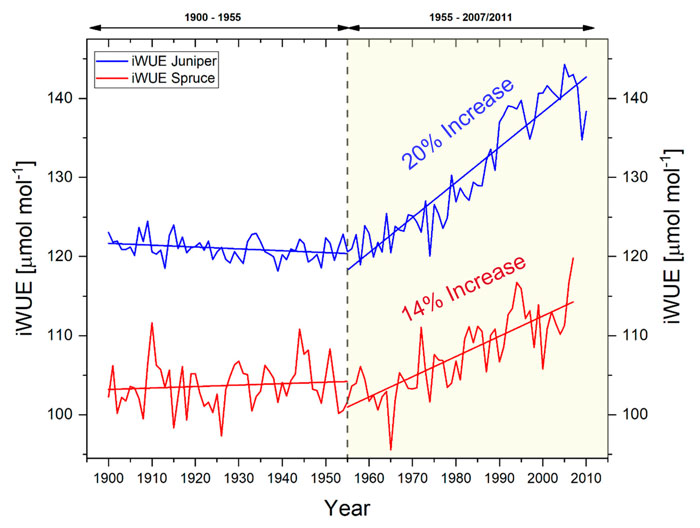| Tweet | Follow @co2science |
Paper Reviewed
Griessinger, J., Bräuning, A., Helle, G., Schlesser, G.H., Hochreuther, P., Meier, W. J.-H. and Zhu, H. 2019. A dual stable isotope approach unravels common climate signals and species-specific responses to environmental change stored in multi-century tree-ring series from the Tibetan Plateau. Geosciences 9: 151; doi:10.3390/geosciences9040151.
It has been conclusively demonstrated in numerous experimental short-term studies that plants produce a greater amount of biomass per unit of water used at higher atmospheric CO2 concentrations then they do at lower ones (see, for example, the several reviews we have posted on the topic in our Subject Index under the heading of Water Use Efficiency). Fewer are the studies documenting this phenomenon over the long term out in the real world of nature. However, the latest study to confirm as much comes from the work of Griessinger et al. (2019).
Publishing their findings in the journal Geosciences, the seven-member research team calculated the intrinsic water use efficiency (iWUE), defined as the ratio of net photosynthetic assimilation rate to stomatal conductance for water vapor, of juniper (Juniperus tibetica) and spruce (Picea balfouriana) trees growing at a high mountain site on the southeastern Tibetan Plateau. The resultant series is presented in the figure below.
As seen in Figure 1, there was little long-term change in iWUE over the first half of the 20th century, during which time atmospheric CO2 concentrations rose by a meager 11 ppm. However, during the second half of the 20th century and on up through the end of their record in 2007, the air's CO2 concentration rose by a much larger 72 ppm, which positively impacted iWUE. For spruce, the increase in iWUE over this recent interval amounted to 14%, whereas for juniper it was an even more incredible 20%.
In commenting on these findings, Griessinger et al. say they are "in good accordance to existing studies from the Tibetan Plateau dealing with Pinus and Abies species, where similar positive trends in iWUE were reported for the last decades," citing the works of Xu et al. (2013) and Huang et al. (2017). And thus their work adds to the ever-growing body of literature demonstrating real-world evidence of what short-term laboratory and field experimental studies have concluded, that rising atmospheric CO2 increases plant water use efficiency. And that is exceptionally good news for plants growing in arid regions where water is a limiting factor to growth.

Figure 1. Intrinsic water-use efficiencies (iWUE) for Juniperus tibetica and Picea balfouriana at a high mountain site on the southeastern Tibetan Plateau. Vertical dashed line indicates dividing line between two investigation periods, 1900-1954 and 1955-2007. Percentage increases in iWUE for the latter period are listed for each tree species. Source: Griessinger et al. (2019).
References
Huang, R., Zhu, H., Liu, X., Liang, E., Griessinger, J., Wu, G., Li, X. and Bräuning, A. 2017. Does increasing intrinsic water use efficiency (iWUE) stimulate tree growth at natural timberline on the southeastern Tibetan plateau? Global and Planetary Change 148: 217-226.
Xu, G., Liu, X., Qin, D., Chen, T., An,W., Wang,W., Wu, G., Zeng, X. and Ren, J. 2013. Climate warming and increasing atmospheric CO2 have contributed to increased water use efficiency on the northeastern Tibetan plateau since 1850. Trees 27: 465-475.
Posted 28 June 2019



